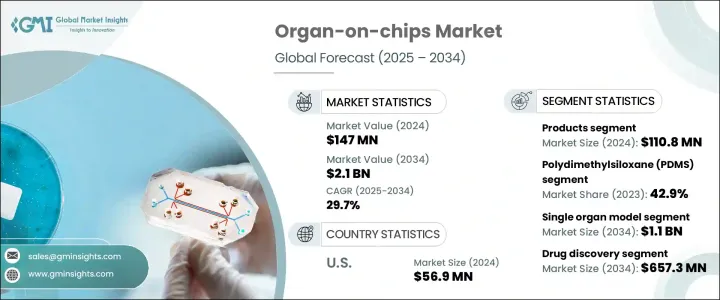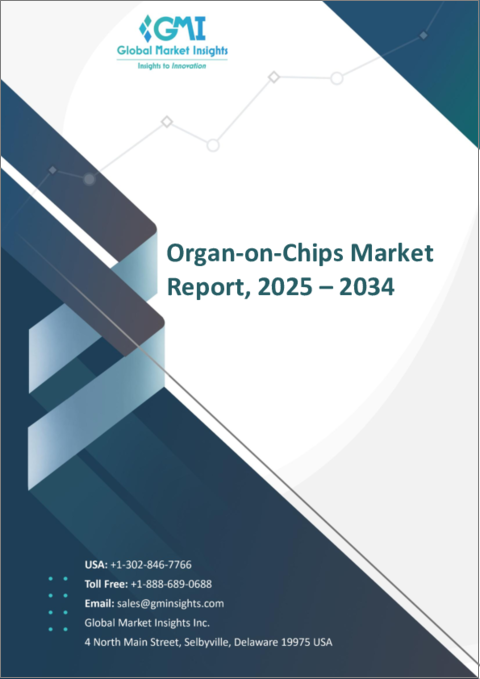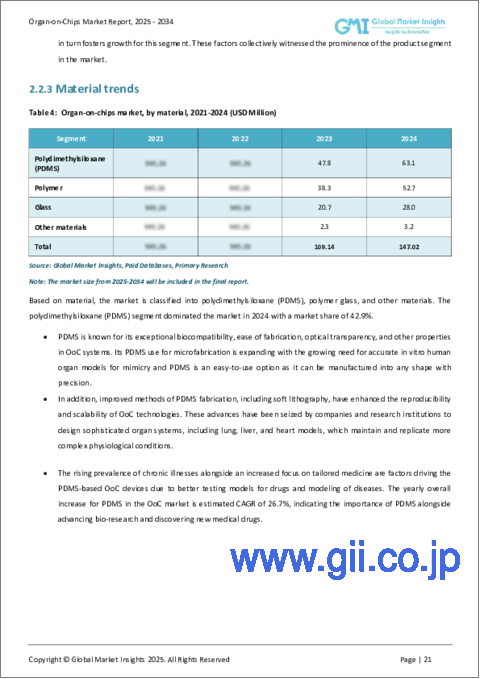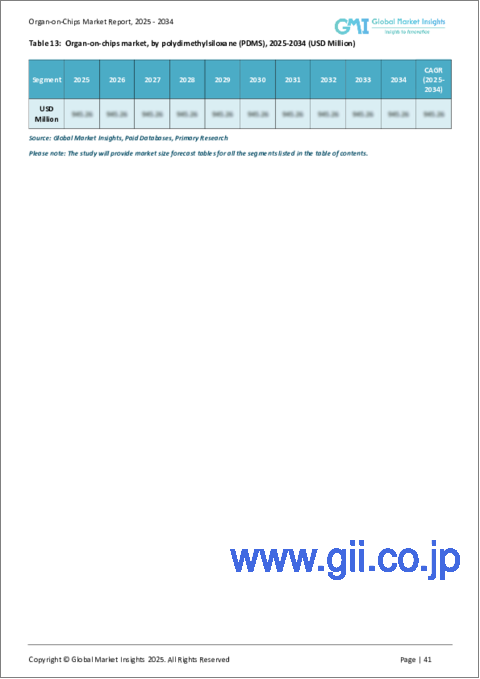|
|
市場調査レポート
商品コード
1750355
臓器オンチップの市場機会、成長促進要因、産業動向分析、2025~2034年予測Organ-on-chips Market Opportunity, Growth Drivers, Industry Trend Analysis, and Forecast 2025 - 2034 |
||||||
カスタマイズ可能
|
|||||||
| 臓器オンチップの市場機会、成長促進要因、産業動向分析、2025~2034年予測 |
|
出版日: 2025年05月12日
発行: Global Market Insights Inc.
ページ情報: 英文 140 Pages
納期: 2~3営業日
|
全表示
- 概要
- 目次
臓器オンチップの世界市場規模は、2024年に1億4,700万米ドルとなり、CAGR 29.7%で成長し、2034年には21億米ドルに達すると予測されています。
需要の急増の背景には、動物実験を減らすという緊急の必要性、組織工学とマイクロ流体工学における現在進行中のブレークスルー、精密医療と合理化された医薬品開発へのシフトの高まりがあります。また、ヒトの生理学に対する正確な洞察を提供できる、より迅速で費用対効果の高い前臨床試験ソリューションに対する嗜好も高まっています。

慢性疾患は世界的に増加の一途をたどっており、ヘルスケアや研究システムにとって、疾患経路や治療反応をより深く理解するための革新的な技術を導入することへのプレッシャーが高まっています。このような疾患は、個々の患者に合わせた研究モデルを必要とするため、臓器オンチップ(OoC)装置の採用が広がっています。これらの小型システムは、試験管内でヒトの臓器の機能を模倣しており、より現実的でヒトに関連した方法で疾患行動や薬効を研究する新しいアプローチを提供しています。精度、時間、コストの限界から従来の検査方法が実用的でなくなるにつれ、OoCプラットフォームは医学研究と医薬品開発における変革ツールとして認識されつつあります。
| 市場範囲 | |
|---|---|
| 開始年 | 2024 |
| 予測年 | 2025-2034 |
| 開始金額 | 1億4,700万米ドル |
| 予測金額 | 21億米ドル |
| CAGR | 29.7% |
製品タイプ別に見ると、市場は製品とサービスに分けられます。様々な臓器模倣チップを含む製品部門が2024年に最大のシェアを占め、1億1,080万米ドルの収益を上げています。これらのチップは臓器の生理学的・機能的側面を再現し、研究者に薬物スクリーニングや疾患モデリングのためのより良いツールを提供します。現実の人間の臓器反応を模倣する能力は、旧来のテストモデルに対する競争優位性をもたらします。
材料別に分析すると、ポリジメチルシロキサン(PDMS)が2023年の市場をリードし、シェアは42.9%でした。この材料は、優れた生体適合性、透明性、製造における使いやすさで際立っています。その柔軟性により、研究者はヒト組織を忠実に再現した複雑な臓器オンチップ構造を作成することができます。PDMSをベースとした製造方法の技術的改善により、臓器オンチップ技術を進歩させる重要な要素である精度、拡張性、再現性が向上しました。その結果、複雑な試験環境をサポートするモデルの開発を目指す研究所や商業研究施設での採用が加速しています。
モデルの種類によって、市場は単一臓器モデルと多臓器モデルに区分されます。2024年には単一臓器チップが主流を占め、2034年には11億米ドルに達すると予測されています。これらのモデルは、シンプルでコストが低く、特定の生理機能に特化しているため、好まれています。薬物毒性、薬力学、疾患特異的反応の的を絞った評価が可能であるため、初期段階の研究に適しています。メンテナンスと製造工程が簡単なため、これらのチップは学術的、商業的な研究セットアップで広く使用できる実用的なものとなっています。
臓器オンチップ市場は用途別に、創薬、疾患モデリング、毒性試験、個別化医療、その他の用途に分類されます。2024年は創薬分野がリードし、2034年には6億5,730万米ドルに成長すると予測されています。OoCシステムの高い精度と予測能力により、製薬会社は医薬品開発中の試行錯誤を最小限に抑えることができます。これらのシステムは動物実験への依存を減らし、ヒトに関連したデータを提供することで、薬剤の失敗を早期に発見し、後期臨床試験の損失を減らすのに役立ちます。
最終用途別では、市場は製薬・バイオテクノロジー企業、学術・研究機関、その他に区分されます。製薬・バイオテクノロジー分野は2024年に最も高い収益を上げ、2034年には14億米ドルに達すると予測されています。このセグメントは、開発コストを削減し、前臨床試験の精度を向上させ、ヒト試験に関連するリスクを低減する必要性から利益を得ています。企業は、ヒト組織のより正確なシミュレーションを作成し、新薬候補に対する反応をより効果的に試験するため、OoC技術に注目しています。
米国は、2022年の3,080万米ドルから2023年には4,260万米ドルに成長した後、2024年には市場の5,690万米ドルを占め、優位性を維持しています。2025年から2034年にかけて、米国市場はCAGR 28.6%で成長すると予測されています。強力な研究資金、高度なヘルスケアインフラ、支持的な規制イニシアチブなどの要因が、この地域の市場成長を後押ししています。動物実験に代わる方法を模索する同国の取り組みは、堅調な民間・公的投資とともに、OoC技術の拡大を支え続けています。
主要企業が市場全体の約60%のシェアを占め、継続的な技術革新とより高度な新型チップモデルの発売を通じて業界情勢を形成しています。個々の生物学に合わせたカスタマイズ・ソリューションへの関心が高まる中、臓器オンチップ市場は医薬品開発、安全性試験、個別化医療戦略に不可欠な存在に急速になりつつあります。
目次
第1章 調査手法と範囲
第2章 エグゼクティブサマリー
第3章 業界考察
- エコシステム分析
- 業界への影響要因
- 促進要因
- 慢性疾患の有病率の増加
- 個別化医療の需要増加
- 臓器オンチップ技術の進歩
- バイオメディカルアプリケーションにおける臓器オンチップモデルの利用拡大
- 業界の潜在的リスク&課題
- 臓器チップ技術の実装における課題と複雑さ
- 規制上の障害が市場の成長を阻害
- 促進要因
- 成長可能性分析
- 規制情勢
- トランプ政権による関税への影響
- 貿易への影響
- 貿易量の混乱
- 報復措置
- 業界への影響
- 供給側の影響(原材料)
- 主要原材料の価格変動
- サプライチェーンの再構築
- 生産コストへの影響
- 需要側の影響(販売価格)
- 最終市場への価格伝達
- 市場シェアの動向
- 消費者の反応パターン
- 供給側の影響(原材料)
- 影響を受ける主要企業
- 戦略的な業界対応
- サプライチェーンの再構成
- 価格設定と製品戦略
- 政策関与
- 展望と今後の検討事項
- 貿易への影響
- ポーター分析
- PESTEL分析
第4章 競合情勢
- イントロダクション
- 企業マトリックス分析
- 企業の市場シェア分析
- 主要市場企業の競合分析
- 競合ポジショニングマトリックス
- 戦略ダッシュボード
第5章 市場推計・予測:製品タイプ別、2021-2034
- 主要動向
- 製品
- 肝臓チップ
- 肺オンチップ
- 心臓オンチップ
- 腎臓オンチップ
- その他の製品タイプ
- サービス
第6章 市場推計・予測:材料別、2021-2034
- 主要動向
- ポリジメチルシロキサン(PDMS)
- ポリマー
- ガラス
- その他の材料
第7章 市場推計・予測:モデルの種類別、2021-2034
- 主要動向
- 単一臓器モデル
- 多臓器モデル
第8章 市場推計・予測:用途別、2021-2034
- 主要動向
- 創薬
- 疾患モデリング
- 毒性試験
- 個別化医療
- その他の用途
第9章 市場推計・予測:最終用途別、2021-2034
- 主要動向
- 製薬およびバイオテクノロジー企業
- 学術研究機関
- その他の最終用途
第10章 市場推計・予測:地域別、2021-2034
- 主要動向
- 北米
- 米国
- カナダ
- 欧州
- ドイツ
- 英国
- フランス
- スペイン
- イタリア
- オランダ
- アジア太平洋地域
- 中国
- 日本
- インド
- オーストラリア
- 韓国
- ラテンアメリカ
- ブラジル
- メキシコ
- アルゼンチン
- 中東・アフリカ
- 南アフリカ
- サウジアラビア
- アラブ首長国連邦
第11章 企業プロファイル
- Altis Biosystems
- AlveoliX
- Axosim
- Beonchip
- Bi/ond Solutions
- Cherry Biotech
- CN Bio Innovations
- Emulate
- Hesperos
- InSphero
- MesoBioTech
- Mimetas
- NETRI
- React4Life
- TissUse
The Global Organ-On-Chips Market was valued at USD 147 million in 2024 and is estimated to grow at a CAGR of 29.7% to reach USD 2.1 billion by 2034. The surge in demand is driven by the urgent need to reduce animal testing, ongoing breakthroughs in tissue engineering and microfluidics, and the growing shift toward precision medicine and streamlined drug development. There is also a rising preference for faster, more cost-effective preclinical testing solutions that can provide accurate insights into human physiology.

Chronic diseases continue to rise globally, placing increasing pressure on healthcare and research systems to adopt innovative technologies that allow a deeper understanding of disease pathways and therapeutic responses. These conditions, which require tailored research models, have led to wider adoption of organ-on-chip (OoC) devices. These miniature systems mimic the functions of human organs in vitro, offering a new approach to studying disease behavior and drug effects in a more realistic and human-relevant manner. As traditional testing methods become less practical due to limitations in accuracy, time, and cost, OoC platforms are being recognized as transformative tools in medical research and pharmaceutical development.
| Market Scope | |
|---|---|
| Start Year | 2024 |
| Forecast Year | 2025-2034 |
| Start Value | $147 Million |
| Forecast Value | $2.1 Billion |
| CAGR | 29.7% |
In terms of type, the market is divided into products and services. The products segment, which includes various organ-mimicking chips, accounted for the largest share in 2024, generating USD 110.8 million in revenue. These chips replicate the physiological and functional aspects of organs, offering researchers better tools for drug screening and disease modeling. Their ability to imitate real-life human organ responses gives them a competitive edge over older testing models.
When analyzed by material, polydimethylsiloxane (PDMS) led the market in 2023, with a share of 42.9%. This material stands out due to its excellent biocompatibility, transparency, and ease of use in manufacturing. Its flexibility allows researchers to create intricate organ-on-chip structures that closely replicate human tissues. Technological improvements in PDMS-based fabrication methods have allowed for greater accuracy, scalability, and reproducibility, which are key factors in advancing organ-on-chip technologies. This, in turn, has fueled adoption across laboratories and commercial research facilities aiming to develop models that support complex testing environments.
Based on model type, the market is segmented into single organ models and multi-organ models. Single organ chips dominated in 2024 and are expected to reach USD 1.1 billion by 2034. These models are favored for their simplicity, lower cost, and focus on specific physiological functions. They enable targeted evaluation of drug toxicity, pharmacodynamics, and disease-specific responses, making them a preferred choice for early-phase studies. The straightforward maintenance and manufacturing processes make these chips practical for widespread use across academic and commercial research setups.
By application, the organ-on-chips market is categorized into drug discovery, disease modeling, toxicity testing, personalized medicine, and other uses. The drug discovery segment took the lead in 2024 and is projected to grow to USD 657.3 million by 2034. The high accuracy and predictive capabilities of OoC systems allow pharmaceutical companies to minimize trial and error during drug development. These systems reduce reliance on animal testing and provide human-relevant data, helping to identify drug failures earlier and reduce late-stage clinical trial losses.
Regarding end users, the market is segmented into pharmaceutical and biotechnology companies, academic and research institutes, and others. The pharmaceutical and biotechnology segment held the highest revenue in 2024 and is anticipated to reach USD 1.4 billion by 2034. This segment benefits from the need to cut down on development costs, improve the precision of preclinical testing, and reduce the risks associated with human trials. Companies are turning to OoC technology to produce more accurate simulations of human tissues and test reactions to new drug candidates more effectively.
The United States accounted for USD 56.9 million of the market in 2024, maintaining its dominance after growing from USD 30.8 million in 2022 to USD 42.6 million in 2023. Between 2025 and 2034, the U.S. market is forecast to grow at a CAGR of 28.6%. Factors such as strong research funding, advanced healthcare infrastructure, and supportive regulatory initiatives have fueled market growth in the region. The country's commitment to exploring alternatives to animal testing, along with robust private and public investments, continues to support the expansion of OoC technologies.
Leading companies account for around 60% of the overall market share, shaping the industry landscape through continuous innovation and the launch of new, more advanced chip models. With growing interest in customized solutions tailored to individual biology, the organ-on-chips market is rapidly becoming an integral part of drug development, safety testing, and personalized medicine strategies.
Table of Contents
Chapter 1 Methodology and Scope
- 1.1 Market scope and definitions
- 1.2 Research design
- 1.2.1 Research approach
- 1.2.2 Data collection methods
- 1.3 Base estimates and calculations
- 1.3.1 Base year calculation
- 1.3.2 Key trends for market estimation
- 1.4 Forecast model
- 1.5 Primary research and validation
- 1.5.1 Primary sources
- 1.5.2 Data mining sources
Chapter 2 Executive Summary
- 2.1 Industry 3600 synopsis
Chapter 3 Industry Insights
- 3.1 Industry ecosystem analysis
- 3.2 Industry impact forces
- 3.2.1 Growth drivers
- 3.2.1.1 Increasing prevalence of chronic disease
- 3.2.1.2 Increasing demand for personalized medicine
- 3.2.1.3 Growing advancement in organ-on-chip technology
- 3.2.1.4 Expanding use of organ-on-chip models in biomedical applications
- 3.2.2 Industry pitfalls and challenges
- 3.2.2.1 Challenges and intricacies in implementing organ-on-chip techniques
- 3.2.2.2 Regulatory obstacles hinder the market growth
- 3.2.1 Growth drivers
- 3.3 Growth potential analysis
- 3.4 Regulatory landscape
- 3.5 Trump administration tariffs
- 3.5.1 Impact on trade
- 3.5.1.1 Trade volume disruptions
- 3.5.1.2 Retaliatory measures
- 3.5.2 Impact on the Industry
- 3.5.2.1 Supply-side impact (raw materials)
- 3.5.2.1.1 Price volatility in key materials
- 3.5.2.1.2 Supply chain restructuring
- 3.5.2.1.3 Production cost implications
- 3.5.2.2 Demand-side impact (selling price)
- 3.5.2.2.1 Price transmission to end markets
- 3.5.2.2.2 Market share dynamics
- 3.5.2.2.3 Consumer response patterns
- 3.5.2.1 Supply-side impact (raw materials)
- 3.5.3 Key companies impacted
- 3.5.4 Strategic industry responses
- 3.5.4.1 Supply chain reconfiguration
- 3.5.4.2 Pricing and product strategies
- 3.5.4.3 Policy engagement
- 3.5.5 Outlook and future considerations
- 3.5.1 Impact on trade
- 3.6 Porter's analysis
- 3.7 PESTEL analysis
Chapter 4 Competitive Landscape, 2024
- 4.1 Introduction
- 4.2 Company matrix analysis
- 4.3 Company market share analysis
- 4.4 Competitive analysis of major market players
- 4.5 Competitive positioning matrix
- 4.6 Strategy dashboard
Chapter 5 Market Estimates and Forecast, By Type, 2021 - 2034 ($ Mn)
- 5.1 Key trends
- 5.2 Products
- 5.2.1 Liver-on-chip
- 5.2.2 Lung-on-chip
- 5.2.3 Heart-on-chip
- 5.2.4 Kidney-on-chip
- 5.2.5 Other products
- 5.3 Services
Chapter 6 Market Estimates and Forecast, By Material, 2021 - 2034 ($ Mn)
- 6.1 Key trends
- 6.2 Polydimethylsiloxane (PDMS)
- 6.3 Polymer
- 6.4 Glass
- 6.5 Other materials
Chapter 7 Market Estimates and Forecast, By Model Type, 2021 - 2034 ($ Mn)
- 7.1 Key trends
- 7.2 Single organ model
- 7.3 Multi-organ model
Chapter 8 Market Estimates and Forecast, By Application, 2021 - 2034 ($ Mn)
- 8.1 Key trends
- 8.2 Drug discovery
- 8.3 Disease modeling
- 8.4 Toxicity testing
- 8.5 Personalized medicine
- 8.6 Other applications
Chapter 9 Market Estimates and Forecast, By End Use, 2021 - 2034 ($ Mn)
- 9.1 Key trends
- 9.2 Pharmaceutical and biotechnology companies
- 9.3 Academic and research institutes
- 9.4 Other end use
Chapter 10 Market Estimates and Forecast, By Region, 2021 - 2034 ($ Mn)
- 10.1 Key trends
- 10.2 North America
- 10.2.1 U.S.
- 10.2.2 Canada
- 10.3 Europe
- 10.3.1 Germany
- 10.3.2 UK
- 10.3.3 France
- 10.3.4 Spain
- 10.3.5 Italy
- 10.3.6 Netherlands
- 10.4 Asia Pacific
- 10.4.1 China
- 10.4.2 Japan
- 10.4.3 India
- 10.4.4 Australia
- 10.4.5 South Korea
- 10.5 Latin America
- 10.5.1 Brazil
- 10.5.2 Mexico
- 10.5.3 Argentina
- 10.6 Middle East and Africa
- 10.6.1 South Africa
- 10.6.2 Saudi Arabia
- 10.6.3 UAE
Chapter 11 Company Profiles
- 11.1 Altis Biosystems
- 11.2 AlveoliX
- 11.3 Axosim
- 11.4 Beonchip
- 11.5 Bi/ond Solutions
- 11.6 Cherry Biotech
- 11.7 CN Bio Innovations
- 11.8 Emulate
- 11.9 Hesperos
- 11.10 InSphero
- 11.11 MesoBioTech
- 11.12 Mimetas
- 11.13 NETRI
- 11.14 React4Life
- 11.15 TissUse






